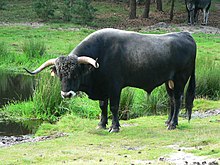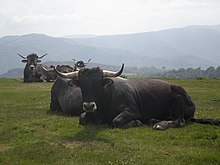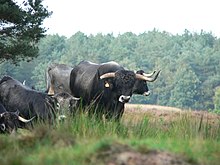



The Tudanca is a traditional Spanish breed of cattle from Cantabria, in northern Spain. It takes its name from the village of Tudanca in the Comarca de Saja-Nansa [es] in western Cantabria. In the past it was a draught breed, much used for transport of goods to and from the ports of the Cantabrian coast; it is now reared for meat, but is still used in traditional sport of arrastre de piedra, or "stone-dragging". Despite its geographic proximity, it is not closely related to the other cattle breed of Cantabria, the Pasiega.
Appearance and description
Tudanca is a middle-sized cattle breed, with cows reaching 135 cm shoulder height and a weight of 320 kg, bulls reaching 150 cm and 420 kg. The colour of Tudanca goes from greyish to black, cows are lighter than bulls on average. Like the aurochs, Tudanca bulls have a light stripe on their back. Additionally, they often have a light saddle. Typically for Tudanca is the swung back line, which is strongly pronounced in bulls. The cows are smaller and more gracile than the bulls. The long horns of Tudanca are variable, they can be either aurochs-like or swung outwards. Tudanca bulls often carry long curly hair on their front head, which is a feature also described for the aurochs.
José María de Cossío describes the breed as "agile, strong, frugal and hardy". Tudancas are adapted to the mountainous orography and climate of the Cantabrian upland. Indeed, herds are moved up to the high pastures to graze on June where they are left until October.
Range and use
Tudancas were formerly used in inner Cantabria as work animals in the field, but after the mechanization of agriculture, the breed was listed as protected domestic animal, since it is, like other primitive cattle breeds, facing extinction because its low economical production rate. The efforts of many breeders and the lately recognized quality of its superb meat have stopped declining and livestock grows back. An equation from 2008 counted 12.991 individuals.
Tudancas are used by the Arbeitsgemeinschaft Biologischer Umweltschutz in Soest, Germany, in a semi-feral state in grazing projects to retain an open landscape with its biodiversity. Furthermore, Tudancas are used in the Netherlands for the same purpose, e.g. in Johannahoeve and the Planken Wambuis reserve. Stichting Taurus also uses this breed. There, it is integrated in TaurOs Project, which aims to breed a type of cattle that resembles the aurochs by crossing with other aurochs-like breeds like Sayaguesa Cattle, Pajuna Cattle, Maremmana primitivo and others.
Gallery
-
Tudanca bull in Johannahoeve, Netherlands.
-
 Couple of cows working at the grass crop in Saja valley, Cantabria, in 1983.
Couple of cows working at the grass crop in Saja valley, Cantabria, in 1983.
-
 Tudancas competing in a dragging test in the Day of Cantabria.
Tudancas competing in a dragging test in the Day of Cantabria.
See also
References
- Barbara Rischkowsky, D. Pilling (eds.) (2007). List of breeds documented in the Global Databank for Animal Genetic Resources, annex to The State of the World's Animal Genetic Resources for Food and Agriculture. Rome: Food and Agriculture Organization of the United Nations. ISBN 9789251057629. Accessed January 2017.
- Breed data sheet: Tudanca / Spain (Cattle). Domestic Animal Diversity Information System of the Food and Agriculture Organization of the United Nations. Accessed July 2020.
- Marleen Felius (1995). Cattle Breeds: An Encyclopedia. Doetinchem, Netherlands: Misset. ISBN 9789054390176.
- Raza bovina Tudanca: Datos Generales (in Spanish). Ministerio de Agriculturo, Pesca y Alimentación. Accessed July 2020.
- Raza bovina Tudanca: Datos Morfológicos (in Spanish). Ministerio de Agriculturo, Pesca y Alimentación. Accessed July 2020.
- ^ http://www.iberianature.com/material/cows.html Spanish cows and beefs
- ^ Miguel Fernández Rodríguez, Mariano Gómez Fernández, Juan Vicente Delgado Bermejo, Silvia Adán Belmonte, Miguel Jiménez Cabras (eds.) (2009). Guía de campo de las razas autóctonas españolas (in Spanish). Madrid: Ministerio de Medio Ambiente y Medio Rural y Marino. ISBN 9788449109461.
- ^ Valerie Porter, Lawrence Alderson, Stephen J.G. Hall, D. Phillip Sponenberg (2016). Mason's World Encyclopedia of Livestock Breeds and Breeding (sixth edition). Wallingford: CABI. ISBN 9781780647944.
- ^ El Diario Montañés (1 January 2010). "Las cabezas de ganado tudanco crecieron un 30% en diez años" (in Spanish).
- Bunzel-Drüke, Finck, Kämmer, Luick, Reisinger, Riecken, Riedl, Scharf & Zimball: "Wilde Weiden: Praxisleitfaden für Ganzjahresbeweidung in Naturschutz und Landschaftsentwicklung
- http://www.stichtingtaurus.nl/cStdPage.php?ref=54&userID=84a8818d6ca464282b76af6952d97d46 Stichting Taurus
External links
- http://www.infocarne.com/bovino/raza_tudanca.htm
- http://www.stichtingtaurus.nl/
- http://www.feagas.com/index.php/es/razas/bovino/tudanca
| Cattle breeds of Spain | |||||
|---|---|---|---|---|---|
| These are the cattle breeds considered in Spain to be wholly or partly of Spanish origin. Inclusion here does not necessarily imply that a breed is predominantly or exclusively Spanish. | |||||
| |||||
|